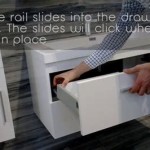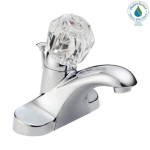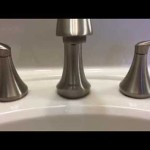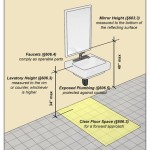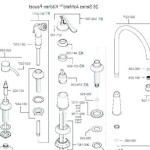Bathroom Sink Still Clogged After Cleaning the P Trap? Here's Why and How to Fix It
A clogged bathroom sink can be a frustrating nuisance. Even if you've cleaned the P trap, the problem may persist. While the P trap is a common culprit in slow drains, other factors can contribute to a persistent clog. This article will explore potential reasons why your sink is still clogged despite cleaning the P trap, offer effective solutions, and provide essential preventative measures.
Understanding the P Trap and Its Limitations
The P trap is a curved pipe located beneath your bathroom sink. It's designed to hold a small amount of water, creating a seal that prevents sewer gases from entering your home. While the P trap is crucial for sanitation, it can also be a prime location for hair, soap scum, and other debris to accumulate, causing blockages. Cleaning the P trap involves removing the curved section, emptying its contents, and rinsing it thoroughly. However, cleaning the P trap alone may not always solve a stubborn clog.
Potential Causes for Clogged Bathroom Sinks Beyond the P Trap
If your sink is still clogged after cleaning the P trap, it's time to investigate other potential culprits. These may include:
1. Clogs Further Down the Drain Line
The clog may be located further down the drain line, beyond the P trap. The drain line connects the sink to the main sewer line. Over time, hair, soap scum, grease, and other debris can build up in the drain line, creating significant blockages. This explains why cleaning only the P trap might not address the underlying problem.
2. Hair and Debris Accumulation in the Drain Stopper
The drain stopper, a small metal or plastic piece that seals the drain, can trap hair and debris. When these accumulate, they can form a clog that prevents water from flowing freely. Even if the drain stopper appears clean, it may still conceal a clog if it's not disassembled and cleaned thoroughly.
3. Mineral Buildup in the Drain Pipes
Hard water containing minerals like calcium and magnesium can lead to mineral buildup within the drain pipes. This buildup can restrict water flow and effectively create a clog. Mineral buildup is common in areas with hard water sources. It can be a challenging issue that requires specialized solutions.
4. Damaged or Obstructed Drain Pipes
In some cases, the drain pipes themselves may be damaged or obstructed. This can occur due to corrosion, tree roots invading the sewer line, or other external factors. Damaged pipes can cause blockages that are difficult to resolve without professional intervention.
Solutions for Persistent Bathroom Sink Clogs
Tackling a stubborn bathroom sink clog requires a systematic approach. Here's how to proceed:
1. Plunge the Drain
A plunger is the first line of defense against clogged drains. Use a cup plunger, ensuring its rubber cup completely covers the drain opening. Create a strong suction and push and pull vigorously. If this works, you've successfully dislodged the clog. However, if the plunger isn't effective, move on to the next solution.
2. Use a Drain Snake
A drain snake, also known as a plumbing snake, is a long, flexible cable with a looped or barbed head. Insert the snake into the drain opening and carefully maneuver it to break up the clog. Depending on the length of the drain line and the severity of the clog, this may require some effort. Remember to use caution to avoid damaging the pipes.
3. Use a Chemical Drain Cleaner
Chemical drain cleaners are powerful solutions that can dissolve clogs. However, they can also be harsh on pipes and hazardous to health. Always read the product label carefully and follow the manufacturer's instructions. Avoid using chemical cleaners if you suspect a pipe blockage, as they may not be effective in this situation.
4. Professional Drain Cleaning
If all other solutions fail, it's time to call a professional plumber. They have specialized tools and expertise to diagnose and address complex clogs. A professional plumber can use a high-pressure water jet to clear blockages in the drain line or even identify and repair damaged pipes.
Preventative Measures
Preventing bathroom sink clogs is easier than tackling them once they occur. Implement these measures to keep drains flowing smoothly:
1. Regularly Clean the P Trap
Cleaning the P trap regularly helps prevent hair, soap scum, and other debris from accumulating and causing blockages. It's a simple procedure that can be done as part of your bathroom cleaning routine.
2. Use a Hair Catcher
A hair catcher, typically a small mesh screen, placed over the drain opening can effectively trap hair and prevent it from entering the drain line. Regularly empty the hair catcher to avoid clogging.
3. Be Mindful of Down-the-Drain Items
Avoid pouring grease, oil, coffee grounds, or other substances that can solidify and create clogs down the drain. Be mindful of disposables and ensure they are properly disposed of, not flushed down the drain where they can contribute to blockages.
A clogged bathroom sink can be a major inconvenience, but with proper troubleshooting and preventative measures, you can keep your sink flowing smoothly. By understanding the potential causes, applying effective solutions, and implementing preventative habits, you can maintain a clean and functional bathroom environment.

How To Unclog A Bathroom Sink Hana S Happy Home

Clear A Sink Clogged Past The Trap In Minutes Our Recipes For Success

Clear A Sink Clogged Past The Trap In Minutes Our Recipes For Success

Sink Won T Drain After Cleaning P Trap Clogged Past The

Clear A Sink Clogged Past The Trap In Minutes Our Recipes For Success

How To Clear A Clogged Drain Reviews By Wirecutter
What Is The Issue If P Trap Clean But Sink Won T Drain Quora

Why Is My Sink Clogged Mike Diamond

Why Is Your Bathroom Sink Clogged Order A Plumber

Clear A Sink Clogged Past The Trap In Minutes Our Recipes For Success
Related Posts
